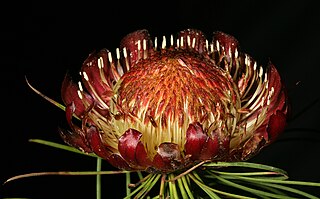
Gasteria is a genus of succulent plants, native to South Africa and the far south-west corner of Namibia.

Gasteria excelsa is a succulent plant, native to the Eastern Cape Province, South Africa.

Astroloba rubriflora is a succulent plant found in the mountainous Karoo area around Robertson, South Africa. It is listed as a Vulnerable species on the IUCN global Red List.

Aloe africana is an arborescent (tree-like) species of aloe plant, indigenous to the Eastern Cape Province, South Africa.

Aloiampelos striatula, formerly Aloe striatula, the hardy aloe or striped-stemmed aloe, is a sturdy succulent plant that naturally occurs on the summits of mountains along the south of the Karoo region of South Africa. Tough and hardy, with bright yellow flowers, it is also cultivated as a garden ornamental.

Leucospermum hypophyllocarpodendron is a creeping, mat-forming shrub with heads of yellow flowers and leathery, upright narrow leaves with some red-tipped teeth at their tips, from the family Proteaceae. It has long thin branches that originate from an underground rootstock and grows on poor, sandy soils in southwestern South Africa. The rose-scented flower heads can be found for August to January and are visited by different monkey beetles, bees and flies. It has two subspecies, one with greyish leaves U-shaped in cross section called grey snakestem pincushion in English and gruisslangbossie in Afrikaans, the other with green leaves that are flat in cross-section called green snakestem pincushion and groenslangbossie.

Gasteria acinacifolia is succulent plant native to the Eastern Cape Province, South Africa.

Haworthia retusa is a species of flowering plants of the genus Haworthia in the family Asphodelaceae, endemic to a very small area around Riversdale, in the Western Cape Province in South Africa. Growing to 10 cm (3.9 in) tall and broad, it is a perennial succulent with thick triangular leaves and small white tubular flowers held in 50 cm (20 in) tall racemes.

Gasteria carinata is a small and variable succulent plant, native to the Western Cape Province, South Africa.

Haworthia bayeri is a species of the genus Haworthia in the family Asphodelaceae, endemic to the southern Cape Provinces in South Africa.

Gasteria polita, the polished gasteria, is a recently discovered succulent plant, restricted to a locality in the Afro-temperate forest of the Western Cape, South Africa.

Drimia elata is a species of flowering plant in the family Asparagaceae, subfamily Scilloideae. It is widely distributed in eastern and southern Africa.

Crassula biplanata is a succulent plant native to rocky ledges and mountainous areas in the southern parts of South Africa.

Pteronia incana is a species of flowering plant in the family Asteraceae, indigenous to the Karoo regions of South Africa.

Cyanella lutea is a species of cormous herb, native to South Africa and southern Namibia, where it grows in clay-rich or loamy soils.

Duvalia elegans is a small succulent plant species, in the family Apocynaceae. It is the type species of the genus Duvalia, and it is endemic to the Western Cape Province, South Africa.

Protea pityphylla, also known as Ceres sugarbush or mountain rose, is a flowering shrub of the genus Protea, in the family Proteaceae. The plant is endemic to the southwestern Cape Region of South Africa.

Gazania ciliaris is a species of flowering plant in the family Asteraceae, native predominantly to the Western Cape province, South Africa, where it occurs from Vanrhynsdorp to the Eastern Cape near Joubertina.

Babiana scabrifolia is a perennial plant of 5–15 cm (2.0–5.9 in) high that annually forms leaves and flowers from an underground corm and is assigned to the Iris family. It produces relatively large, pale lilac or blue flowers slightly above the soil, and soft, lightly pleated leaves that reach beyond the flowers. These leaves are lance-shaped to oblong in adults, but line-shaped and twisted in non-flowering specimens. Flowering occurs from June to August. The species can be found in the Western Cape province of South Africa.

Albuca setosa is a species of small, perennial, bulbous plant in the asparagus family. It is native to the Cape Provinces and KwaZulu-Natal in South Africa.




















